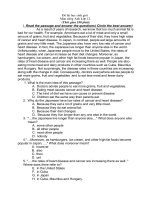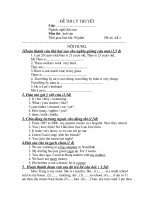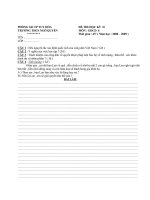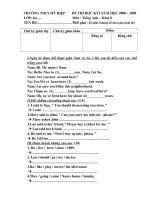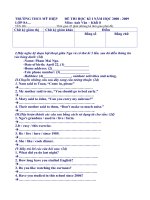ĐỀ THI ANH VĂN NGÀNH THÔNG DỊCH VIÊN ANH-PHÁP 2009 – 2010_2 ppsx
Bạn đang xem bản rút gọn của tài liệu. Xem và tải ngay bản đầy đủ của tài liệu tại đây (72.57 KB, 12 trang )
TRƯỜNG CD VĂN HÓA NGHỆ THUẬT VÀ DU LỊCH SÀI GÒN
ĐỀ THI ANH VĂN NGÀNH THÔNG DỊCH VIÊN ANH-PHÁP 2009 –
2010
THỜI GIAN: 90 PHÚT
Discussion
1. Americans believe strongly in self-reliance and the freedom of individual. At
what age do young people become financially and emotionally independent
from their parents in your country? At what age do they leave home?
2. Is it a good thing for 18-year-olds to leave their parents’ home to lead an
independent life? What are the advantages and disadvantages? What
is your choice? As a parent would you like your children to leave home at
18?
3. Is it healthy for a young person to want to compete? Which is more
important, competing or cooperating? Which does your culture value more?
Why?
4. Choose one basic American value you find most influential in
contemporary
Vietnamese society and analyze its effects on your life.
5. Americans believe strongly in self-reliance and the freedom of individual. At
what age do young people become financially and emotionally independent
from their parents in your country? At what age do they leave home?
6. Is it a good thing for 18-year-olds to leave their parents’ home to lead an
independent life? What are the advantages and disadvantages? What
is your choice? As a parent would you like your children to leave home at
18?
7. Is it healthy for a young person to want to compete? Which is more
important,
competing or cooperating? Which does your culture value more? Why?
8. Which American value are you most impressed?
Comprehension Check
True or False?
1. The United States has diversity just in its climate and geography.
2. The United States has 48 states lying in the central of the North
American continent.
3. The two states were added to the United States in 1959 are not situated
in North
America.
4. The American population is not only one of the world’s largest but also
various in its origins.
5. The largest minority group in the United States is the white.
6. All the Americans speak English with the same accent.
7. The Californians are not as conservative as the Mid-Westerners.
8. Modern transportation and communication help erase all regional
differences.
9. It is impossible to make generalizations about the United States because
it is the land of diversity.
10.
The typical American is third- generation, Hispanic, urban, and rich.
11.
“No one should have to see America for the first time” means visitors need
several visits to America to understand this very big and different land.
Discussion
1. What different ethnic groups are there in your country? Where do they
live? How are they different from the majority of people in your
country: Language? Clothing? Food? Music? Customs? Tell about an
interesting custom or tradition of theirs.
2. Would you like to live and work in multi-cultural environment? Discuss
about the advantages and disadvantages of living in a country of great
ethnic diversity like the USA.
3. Would you like to work in a company of all-Vietnamese staff or one
of international staff?
Overview of U.S.
H
i
sto
r
y
Ten Periods of US History
1. 1492 - Christopher Columbus discovered North America.
1500s - European settlers came to the new land for gold,
adventures, and freedom.
1600s - The colonists lived under British laws.
2. 1775 - Americans in the thirteen colonies wanted to be free of
British rule. General
George Washington led the colonists in the Revolutionary War.
1776 - Thomas Jefferson wrote the Declaration of Independence,
and the colonies approved it.
3. 1783 - The American colonists won the war, and the colonies
became the United
States of America.
1789 - The Constitution became the highest law of the land.
1789 - George Washington became the first President.
4. 1840s - Millions of Europeans came to America as workers during
the Industrial
Revolution. The new nation grew and added more states.
1853 - The USA expanded to the Pacific Ocean.
5. 1861 - Americans fought against one another in the Civil War
between the North and the South.
1863 - President Abraham Lincoln freed the slaves in the
Emancipation
Proclamation.
1865 - The northern states won the war, and the period of
Reconstruction began.
6. 1917 - The US grew to be one of the great powers in the world.
The nation fought in the First World War.
1920 - After the war women got the right to vote for the first time.
7. 1929 - The Great Depression began with the stock market crash.
Banks, factories, and farms shut down, and many Americans were
unemployed.
1933 - President Franklin Roosevelt helped end the Depression with
the New Deal government.
8. 1941 - The United States entered the Second World War when
Japans attacked the
Hawaiian Islands.
1945 - The war ended when the US dropped the first atomic bomb,
and the world entered the Nuclear Age.
9. 1950s - The US entered a time of Cold War. America fought in the
Korean War.
The Civil Right Movement began, and black and white Americans
fought against segregation.
10.
1960s - The Space Age began. Americans fought in the Vietnam
War. The
United
States put the first men onto the moon in the Apollo Program.
1970s - The Women’s Liberation Movement became strong.
1980s - Computers began to change the nation faster than ever before
Comprehension
Check
I/ Read the section “Overview of US History” and write the dates
from the box.
1853 1955 1969 1492 1776 1919 1789 1929 1863 1941
1. Columbus discovered North America. .
2. The colonies approved the Declaration of Independence. .
3. The Constitution became the law of the land. .
4. The United States expanded to the Pacific Ocean. .
5. President Abraham Lincoln freed the slaves. _ .
6. The First World War ended. .
7. The Great Depression began. .
8. The US entered the Second World War. .
9. The Civil Right Movement began. .
10.
The US put the first man on the moon.
II/ Read the section “Exploration and Colonization”. True or False?
1. Christopher Columbus wanted to sail to India but discovered
America.
2. The Spanish explored South America to find gold and freedom of
worship.
3. Priests came to teach the Indians about Europe.
4. The Pilgrim Fathers came to the United States because they
wanted to give freedom of religion to everyone in the new land.
5. The Pilgrim Fathers celebrated the first Thanksgiving to show
thanks to the Indians for helping them.
6. The British established the first permanent settlement in North
America at St.
Augustine, Florida.
7. Native Americans are known as the “Indians”.
8. Thirteen European settlements on the east coast became
colonies of France and
Spain.
9. Some of the settlers were friendly to the Indians and taught them
about the land.
10.
The colonists killed many Indians for self defense.
11.
The people from Holland lived in New York before the British won
control.
12.
Pennsylvania was named after a person, and so was Virginia.
III/ Match the sentence parts. Write the letters on the lines.
1.
The American colonies
had a
a) they couldn’t get rights
from the
large amount of self
government because
2. England got control over
North
America because
British.
b) they wanted to punish the
colonies for the Boston
Tea Party.
c) the colonists couldn’t send
3.
The “Boston Tea
Party”
representatives to England to
vote
occurred
because
on taxes.
4.
The English passed
even
d) the Mother Country was
busy with
stricter laws
because
wars at that time.
5.
The colonies stopped
buying
e) the English won the French and
British goods and prepared
for war because
Indian War
IV/ Multiple-choice
question
1. How many British colonies were there before the Revolution?
a.
13
b.
30
c.
33
2. What was the Stamp Act?
a. A battle in the
Revolutionary War b. A
rebellion
c. A
tax
3. Why did the colonists refuse to pay British taxes?
a. Because they
was poor
b. Because they already had a
lot of taxes
c. Because they didn’t have a vote in the British
government
4. Where did the Continental Congress meet in 1774?
a. In
Philadelphia
b. In Washington,
D. C.
c. In New
York
5. Where did the Revolutionary War start?
a. In
Philadelphia
b. In
Massachusetts c.
In Virginia
6. What did Thomas Jefferson write?
a. The Constitution of the
U.S.
b. The Articles of the
Confederation c. The
Declaration of Independence
7. Where did the Revolutionary War end?
a. In
Philadelphia
b. In
Massachusetts c.
In Virginia
8. When did George Washington become the first U.S. president?
a. in 1776
b. in 1789
c. in 1781
V/ Put these events in the War of Independence in the correct order.
The Revolutionary War started with the Battle of Lexington and
Concord.
The Constitution of the U.S. was written and accepted by the people.
The Colonists protested British taxes in the Boston Tea Party.
George Washington became the first president
The Revolutionary War ended with the battle of Yorktown.
The Continental Congress met in Philadelphia for the first time.
The Declaration of Independence was written and signed.
Britain charged the colonists the tax in the Stamp Act.
The Articles of Confederation set up a weak federal government.
Overview of the History of Immigration
1. (1500s) There were about twenty-five million “native Americans”
(Indians)
living in North and South America.
2. (1600s-1776) The English were the largest immigrant group to settle
in North
America. They were farmers, fishermen, and traders.
3. (1700s) At the time of the American Revolution, there were also
many immigrants from Scotland, Ireland, France, Holland, Germany,
Sweden, and Poland. Most of these settlers were Protestants.
4. (1700s) The Spanish settled mainly in the Southwest, especially
California. They were managers, priests, and soldiers.
Comprehension Check
I/ Choose the correct answers
1. Which of the following was not a characteristic of the dominant
American culture during the early decade of the nation’s history?
a. Catholic
a. western
Europe b.
middle class
2. Which of the following was true about the political bosses in
northeastern cities during the late 19
th
and early 20
th
centuries?
a. They were more afraid of new immigrants than were other
Americans. b. They were more cruel to new immigrants than
were other Americans.
c. They were more helpful to new immigrants than were other
Americans.
3. Today, ethnic groups in the US
a. have no feeling of belonging to an ethnic group
b. are assimilated into the dominant culture in varying
degrees, often depending on how similar their culture is to the
majority.
c. all feel much more a part of their ethnic group than a part of the
dominant culture.
4. In 1954, the US Supreme Court declared that African-Americans in the US
a. could not be denied their right to vote for racial reasons.

